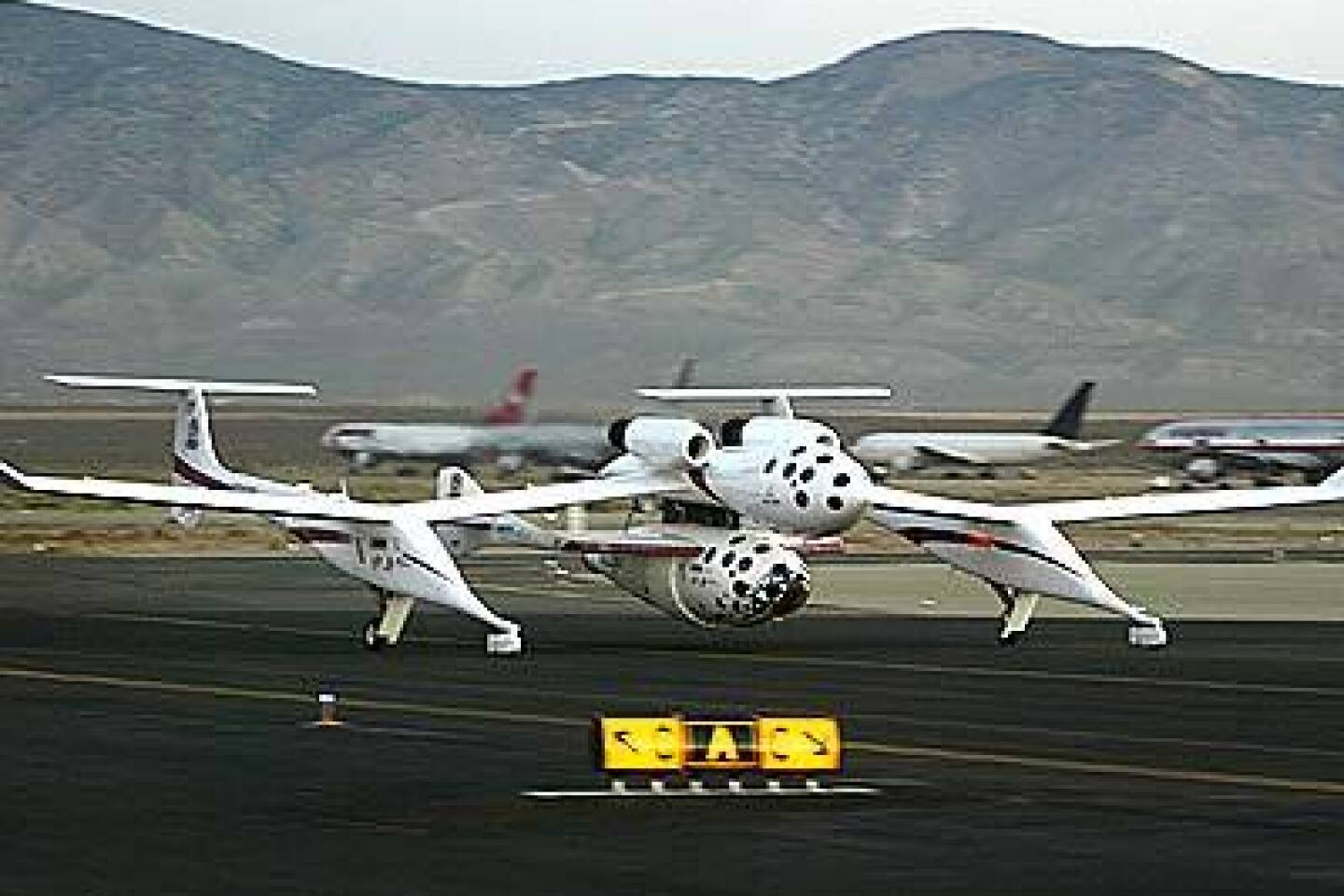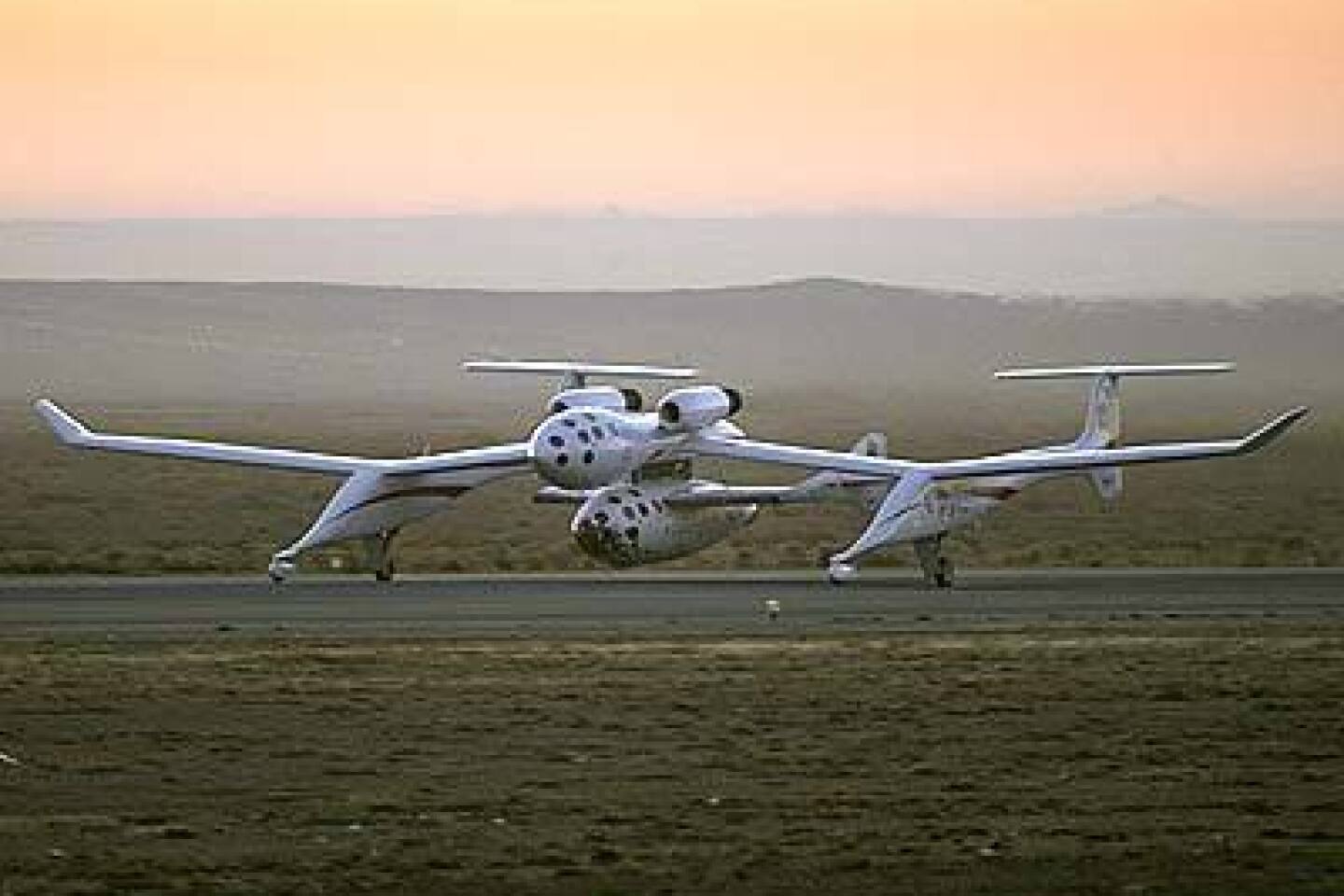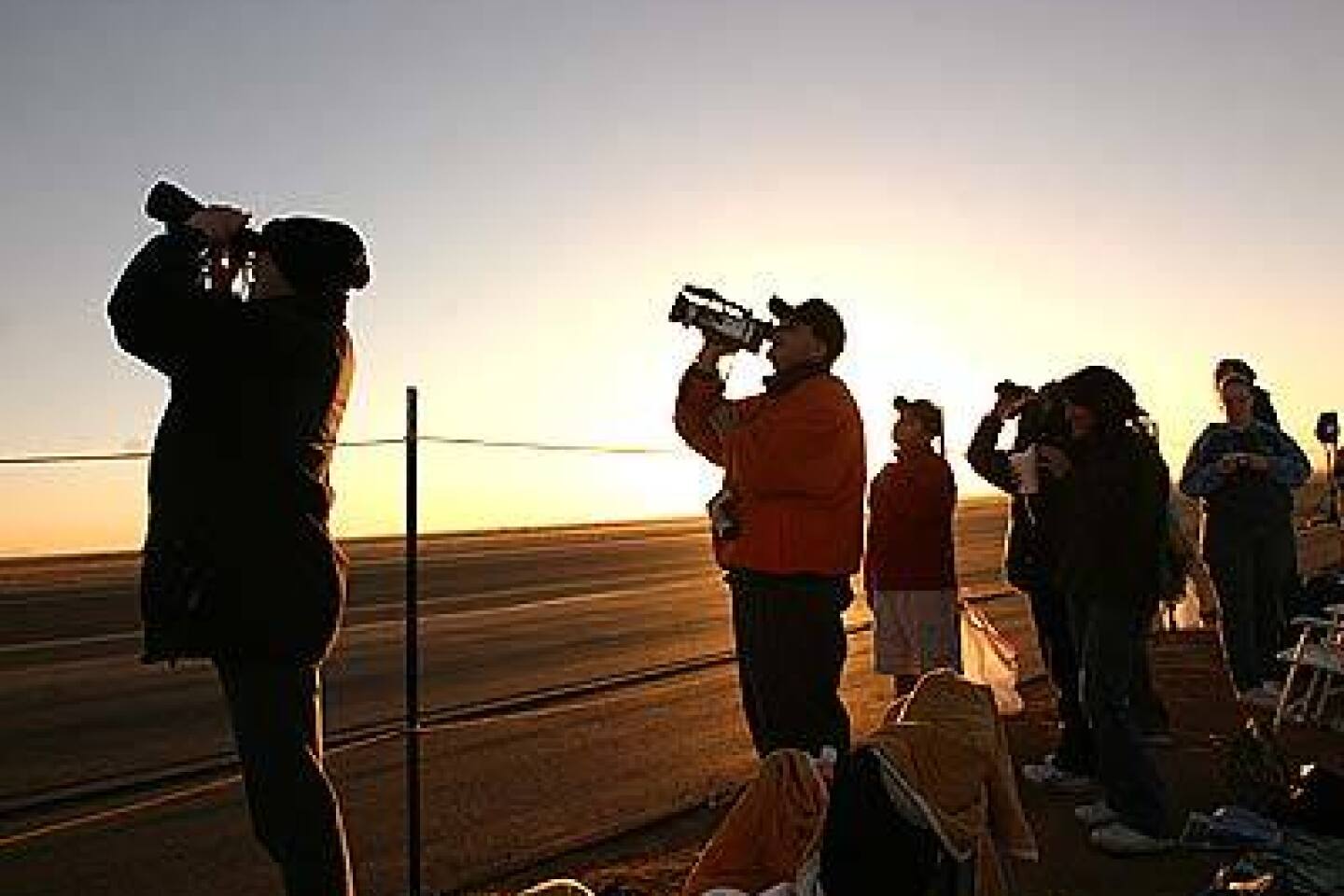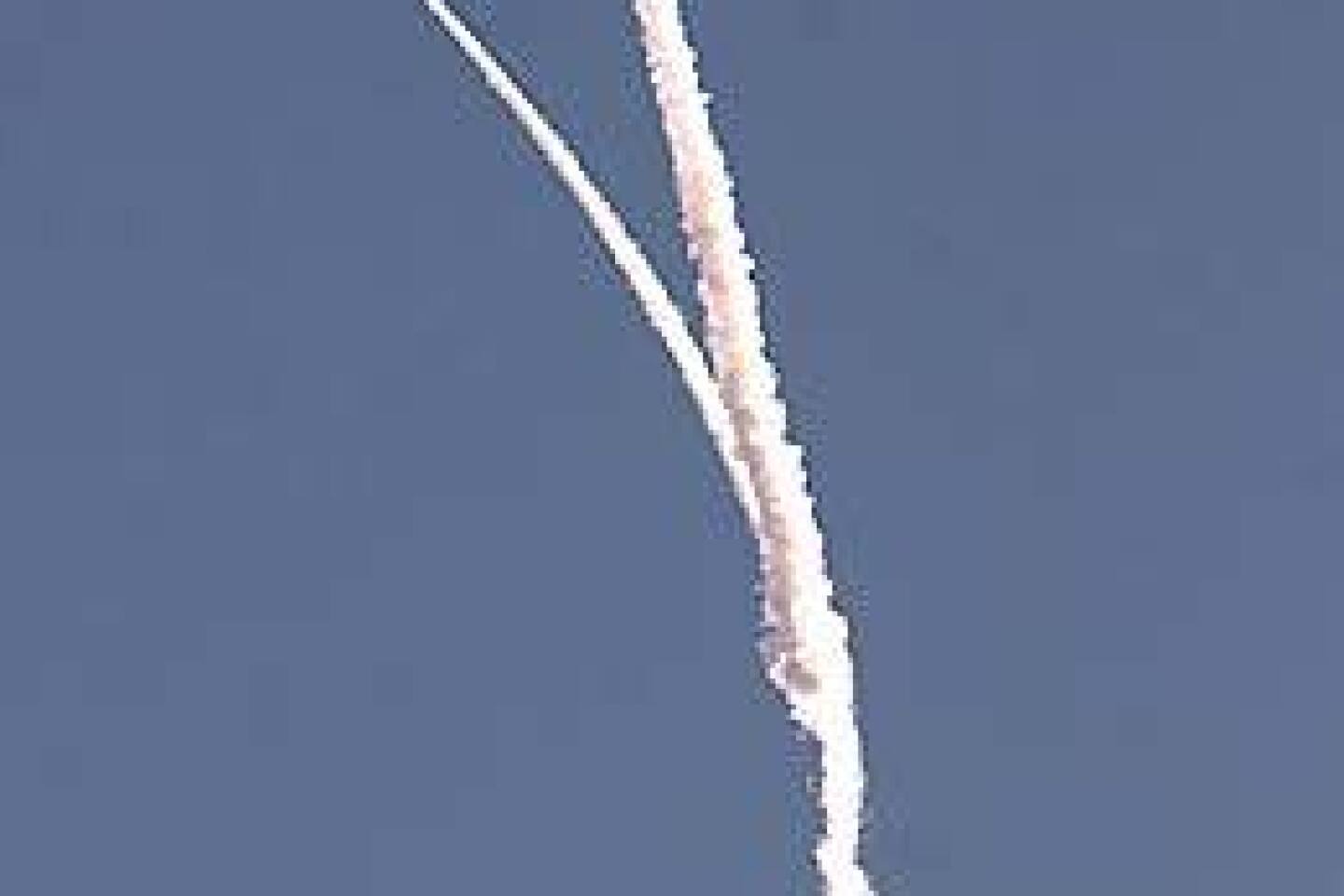Private Rocket Captures $10-Million Prize
- Share via
MOJAVE — SpaceShipOne, a privately funded manned rocket, blasted into space for the second time in less than a week today, claiming a $10-million prize and raising prospects for low-cost, reliable personal space flights.
The small rocket, piloted by former F-18 fighter test pilot Brian Binnie and propelled by a mixture of rubber and laughing gas, climbed to 367,442 feet, well past what is widely considered space, and glided safely back to the airport here before a cheering crowd of more than 10,000.
It marked the third time that the rocket, built by innovative aircraft designer Burt Rutan and financed by Microsoft co-founder Paul Allen, had reached space.
In June, the rocket climbed to 328,491 feet, becoming the first commercial manned space flight. Last Wednesday, the rocket began the first leg of its quest to win the $10-million Ansari X Prize by soaring to 337,500 feet, or 64 miles up.
To win the $10 million prize, a competitor had to reach space twice within two weeks while carrying a pilot and a payload with the equivalent weight of two passengers.
After today’s flight, X Prize judges declared that the rocket had climbed nearly 70 miles into the sky, surpassing an altitude record set by a U.S. Air Force X-15 winged rocket in the 1960s.
“We’re at the birth of a new era, the age of personal space flights,” said Peter Diamandis, a Santa Monica entrepreneur who created the competition in 1996, hoping to spur privately funded space flights. “I’ve been waiting for this day for a very long time.”
Organizers of the competition said the achievement was akin to Charles Lindberg’s successful flight across the Atlantic Ocean in 1927 to win the $25,000 Orteig Prize — albeit with a modern-day MTV-like commercial twist.
The Orteig prize and Lindberg’s flight spurred the growth of the commercial airline industry. People paying to fly in an airplane rose from just 5,800 in 1926 to nearly 420,000 by 1930.
For the X Prize, M&M candy and 7-Up soft drink were two of several sponsors of SpaceShipOne, which included NASCAR-like logos painted on the sides of the rocket.
Whether today’s flight will prompt a similar explosion in private space flights is not clear, although it is raising a host of legal, regulatory and business questions about a nascent industry.
“This is the true frontier of transportation,” Marion Blakely, administrator for the Federal Aviation Administration, said as she watched the rocket shoot straight up into the sky.
While the FAA has had regulatory oversight over airplanes and commercial unmanned rockets to launch satellites, there are no processes to license piloted suborbital vehicles such as SpaceShipOne.
The FAA can license a location — the Mojave Airport for instance — to launch rockets. Congress is considering a bill that would set FAA licensing regulations for suborbital flights, including provisions that would require operators to disclose the safety record of the spaceship. In return, the passengers on the space flights would have to sign a waiver of legal liability.
The provision is considered critical for the growth of the industry. Without the waiver requirement, investors are not likely to fund such a business out of fear of multimillion-dollar claims after an accident.
FAA is facing other daunting questions, including how to write regulations for an industry that is still developing. Many of the technologies are so new that there are no certification processes to determine if they safe to fly.
“We don’t want to over-regulate before the industry gets started,” said Patricia Grace Smith, FAA’s associate administrator for commercial space transportation.
Even the business case is not all that clear.
The research firm Futron estimated that by 2021 more than 15,000 passengers could be making suborbital flights for about $50,000 each. That would make it a $1-billion industry.
But according to a UC Irvine business school professor who studied the prospects for a private, commercial space-launch market, the market may not be able to muster the capital and liability protection to make inexpensive personal space travel a reality.
Hoping to sustain public interest, X Prize officials said today it will be organizing an annual competition starting with an exhibition next year in which at least a dozen rocket makers will vie for million dollar prizes.
Dubbed the X Prize Cup, the 10-day event to be held in Las Cruces, New Mexico will have competitors fly their piloted rockets to win prizes ranging from $1 million to $5 million in various categories, including the rocket that can carry the most payload, go the highest, and repeat a mission in the shortest amount of time.
Diamandis said he is aiming to make the event similar to the Olympics, in which 40 to 50 space flights could take place during the 10-day event, which would be televised by a network. Diamandis said he is talking to a major, non-cable television network about having exclusive rights to televising the event.
In addition to generating sponsors and investors for the rocket developers, Diamandis said the events would help “push the envelope” in the development and research of a passenger-carrying, revenue-generating space business.
“I want to show that there is money to be made and people are investing,” Diamandis said.
Initially, at least for the next several years, much of the focus for most competitors will be on pure research and testing new vehicles such as SpaceShipOne, he said. More than two dozen teams from seven countries vied for the X Prize, but only a handful were considered contenders.
By 2007, the first paying customers could be lofted into space.
Richard Branson, the maverick British billionaire and owner of Virgin Atlantic Airways, last week announced that he was launching a commercial passenger space line and would buy five vehicles from Rutan for $100 million.
The vehicles for Virgin Galactic would be larger versions of SpaceShipOne, carrying five passengers and a pilot. Rutan said during a post-launch press conference that he may continue to fly SpaceShipOne as a research vehicle to help develop SpaceshipTwo.
Branson said the first paying passengers are likely to be well-heeled customers who can afford the initial round-trip air fare of $190,000, a price tag that he said would eventually decline much like the way personal computer costs plummeted.
After several years of such flights, possibility numbering a few thousand, “there would be sufficient base of experience” to open up the market and make passenger space flights routine.
“We’re going to see technology continue to advance through the competitive spirit and that’s going to make space available to everyone,” Diamandis said.
Unlike last Wednesday’s flight in which the rocket rolled 29 times in what seemed to be a harrowing climb, today’s ascent seemed flawless. The rocket was taken to about 49,000 feet, attached to the belly of a spider-like mother ship aircraft before it was released and began its vertical climb.
Asked later if there were any anomalies, flight director Doug Shane answered with a curt: “No.” After the mission, the pilot who took the rocket into space became the second civilian to earn FAA’s new commercial astronaut wings, joining his colleague Mike Melvill, who earned his wings with the June flight into space.
The wings are given to pilots who have flown above 50 miles and virtually all of the more than 400 who have earned them did so on government-funded orbital rockets or space shuttles.
The big winner in the competition appears to be Allen, the Microsoft co-founder, who put up $25 million to develop and build SpaceShipOne. In addition to the $10-million prize, Allen inked a $21-million licensing deal with Branson.
The loser may be the insurance firm that bet no one could make the required flights by the end of the year.
To fund the X Prize award, Diamandis took out a “hole-in-one” policy in which the insurer gets to keep the premium if no one wins the prize, but must pay the $10 million if there is a winner by the deadline. Such policies are commonly taken out by professional sports to conduct $1-million full-court basketball shots or football field goal kicks during halftime.
More to Read
Sign up for Essential California
The most important California stories and recommendations in your inbox every morning.
You may occasionally receive promotional content from the Los Angeles Times.



























